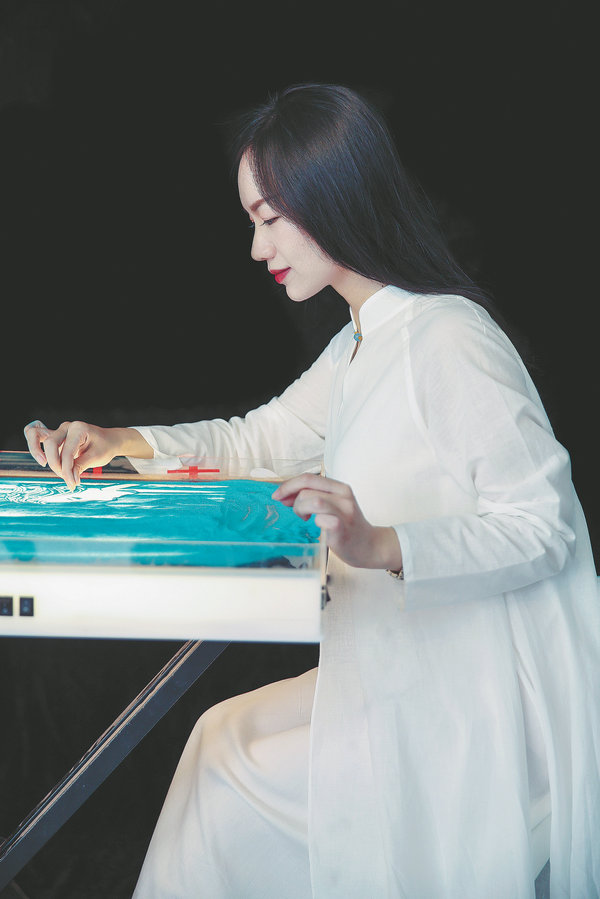

Born to a family of painters in Central China's Hunan province, she started to show her talent in painting as a child. She would often doodle in the sand.
In 2003, at the age of 15, He was enrolled into Wuhan University of Technology on the back of her solid art skills and focused her attention on animation.
The idea of using sand to create images struck He in her sophomore year, when her professor asked the class to use different materials to create an animation.
She wanted to try something different from her peers, who opted for paper-cuts, clay or other conventional materials.
"I remembered the sand, and found that it has a certain fluidity that allows it to be used for animation."
From then on, He focused on exploring the possibilities offered by sand painting.
"The animation studies offered me guidelines and specifications to conduct sand painting," she says.
In addition to grasping essential skills, He looked into the history of sand painting and concentrated on theoretical studies of the medium as well.
The art form features the pouring of colored sands, as well as powdered pigments from minerals or crystals and pigments from other natural or synthetic sources, onto a surface to create images.
"In fact, we can find examples of sand painting as far back as the Song Dynasty (960-1279)," He says.
Evidence can be found in the ancient phrase huadi jiaozi that refers to the mother of Song-era literatus Ouyang Xiu teaching her son how to write and paint on the sand with a reed, she explains.
Moreover, during the Ming (1368-1644) and Qing (1644-1911) dynasties, folk artists often drew on sand as a stunt to peddle their products.
He says she feels it is imperative for people to know that sand painting is a part of Chinese culture.
In 2007, He continued her postgraduate studies in fine arts at Hainan University, where she got to upgrade her understanding of traditional culture and art theory. It laid a solid foundation for her own creations.
"I explored multidisciplinary interactions and various materials that could be used in the art form," she says. "They gave me more inspiration."
After graduation, He got a job offer at the Hainan border defense force art troupe. Since then, she has started traveling around the country to give performances.
Although He often has to carry a heavy sand painting table, it doesn't tire her out. "I enjoy it too much to feel anything else, (because) each performance can be full of surprises," she says.
He likes to improvise, and sand painting can facilitate this.
"If a handful of sand is like a feather when sprayed onto the board, I can build on it," He says. "Therefore, each time the feeling is fresh, which motivates me to continue creating."
But, there's a sense of regret that the product of the art form is fleeting.
"Once the performance is finished, the board will be wiped clean," she says.
Therefore, she has explored ways to prolong the life of her work, including the use of adhesive spray.
"I'm trying to solve the problem step by step," she says.
He spent nearly a decade in the military art troupe, an important phase, she says, for developing her artistic style.
She created many themed sand paintings highlighting the life of frontier soldiers and the country's development, all of which brought joy to the military personnel and further enriched the content of her work.
In 2019, she quit the art troupe and became a teacher at Hainan Normal University. "I wanted to further popularize sand painting and nurture more teachers for children," He says.
In her opinion, sand painting has huge potential in art education among rural children, who have easy access to sand and won't be deterred by financial limitations.
She has also set up a sand painting education facility for children with special needs in Hainan.
"The unique touch of sand has a healing effect on the heart, and I want to help these groups of children through the art of sand painting," she says, adding that those with hearing or vocal issues, are often very smart and enlightened.
Feng Yu, a rural teacher from Qiongshan district of Haikou, Hainan, recently learned about sand painting with He.
"I am amazed by her work," Feng says.
Feng learned to draw simple patterns like trees, clouds and the sea in a training session.
"I'm planning to get some equipment to study it myself before teaching it to my students," Feng says.
At the moment, He is also pursuing her doctoral degree in artificial intelligence and sand painting at Wuhan University of Technology.
"The development of any art, especially modern art, is definitely the result of a multidisciplinary fusion that requires an increased acumen so that your work will have more depth and move more people," she says.
Her team has developed a control terminal that operates a mechanical arm to aid the creation of sand paintings, featuring Chinese characters and images of landmark buildings.
"She has an eye for beauty and an adept hand for expressing it," says Yuan Xiaofang, professor from the university's School of Art and Design. "She also works hard and has made an important contribution to the country's art of sand painting."
He has set her sights on enabling her machine to be able to realize novel creations based on the style of certain artists, demonstrative teaching and user interactions.
"It will further lower the threshold for learning sand painting and enable more people to experience its charm and fun," He says.